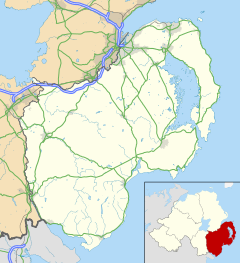Saintfield
Saintfield
|
|
|---|---|
 Main Street, Saintfield |
|
| Saintfield shown within County Down | |
| Population | 3,381 (2011 Census) |
| District | |
| County | |
| Country | Northern Ireland |
| Sovereign state | United Kingdom |
| Post town | BALLYNAHINCH |
| Postcode district | BT24 |
| Dialling code | 028 |
| EU Parliament | Northern Ireland |
| UK Parliament | |
| NI Assembly | |
Saintfield is a village and civil parish in County Down, Northern Ireland. It is about halfway between Belfast and Downpatrick on the A7 road. It had a population of 3,381 in the 2011 Census, made up mostly of commuters working in both south and central Belfast, which is about 11 miles away. The population of the surrounding countryside is mostly involved in farming.
Running east to west across the A7 is the B6 road, and to the west of this crossroads is Main Street, which takes one towards Lisburn and Ballynahinch, and to the east is Station Road which takes one towards Killyleagh.
The area that is now Saintfield was historically called Tawnaghnym (recorded in 1605) or Taunaghnieve (recorded in 1663), which appear to derive from the Irish Tamhnach Naomh or Tamhnaigh Naomh, i.e. ‘field of saints’. The English translation, Saintfield, did not come into use until the 18th century.
In the 16th century, the Saintfield area was part of South Clannaboy owned by Sir Con McNeil Oge O'Neil. His lands were confiscated after a false accusation of disloyalty in 1602 and were granted to Sir James Hamilton in 1605 who 'planted' English and Scottish settlers in the area. Saintfield was originally an early 17th-century settlement, with the first church being built about 1633. In 1709 Hamilton sold the estate to Major General Nicholas Price of Hollymount, County Down, who laid the foundations of the town and renamed it Saintfield in 1712.
Nicholas Price remained owner of the village until his death in 1734 and encouraged linen manufacturers and tradesmen to settle, established a barracks, repaired the parish church and established markets and fairs. The village had a number of corn, flour and flax mills, the remains of which are visible today, and has retained a tradition of textile manufacture through Saintfield Yarns. Development was continued by the Price family and in 1750 the family, headed by Francis Price, grandson of Nicholas, moved to a newly built Saintfield House, just north of the village.
...
Wikipedia

